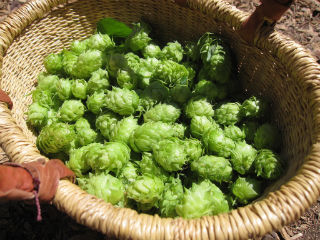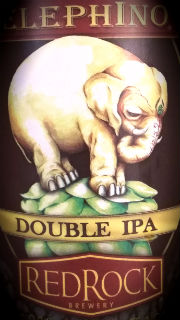 Written by Jeremy Hopkin
Written by Jeremy HopkinIn the last article we got to learn a little bit about the history of hops and how hops got put into beer in the first place. Hopefully you and some of your hop hater friends got to try out Ghost rider for the first (or fiftieth) time! It’s one of my go-to beers these days and I hope you enjoyed yours as much as I enjoyed mine.
Now it’s time to get to the nuts and bolts. Stick in there with me – I am going to talk some chemistry. If you find this nauseating or profoundly boring, just go a grab a left-over ghost rider and drink it while you read. Actually, that was a trick – I know you don’t have any left – you lush!! Anyway, we need to geek out a little bit and talk about some of the chemistry of hops and how they are used in the beer making process to round out our beer IQ.
Just like any other plant, hops has evolved with it’s own armamentarium of phyto chemicals to help it either reproduce, fight disease or repel over eating herbivores. Hops is no exception, and it actually happens to be in a family of plants that produces more than its fair share of biologically active compounds. As we know from last weeks post, hops is used not only for bittering but also as a preservative (anti-bacterial). The actually number of chemical compounds in hops is too abundant for reasonable discussion of them all. For this reason, the chemical compounds of hops are usually combined into three main categories – alpha acids, beta acids and volatile oils.
Alpha acids are responsible for the majority of hops bittering properties. The two most important are humulome and cohumulone. Humulone is a compound for which the taste profile has been isolated and well defined. It is the major contributor to “soft” bitterness in beer. It also has strong anti-bacterial, anti-cancer properties. It is actually being investigated as a compound to treat chronic bronchitis. Got a cold – drink your beer!
The other Alpha acid commonly talked about is cohumulone. This compound is not as well characterized, but it is considered to impart the “harsh” detergent like flavor that some strains of hops can produce. It’s probably a bit presumptuous to denigrate this compound totally, considering the lack of evidence, but high levels are usually considered undesirable in hops and these varieties are usually avoided by brewers. In general, you can think of alpha acids as the bittering substance in hops. Alpha acids are expressed in percentage points in commercially grown hops (in reference to total weight of the hop flower). This gives the brewer an idea of how much bittering potential your package of hops has.

This is just the beginning of the story though. Alpha acids are actually not very active in the form that they are stored in the hop cone. The isomerized form of alpha acids is the actual compound that sticks to the receptors on your tongue and in the olfactory mucosa, sending electrical signals to your brain saying – hey that’s bitter! Isomerization is a chemical process where a compound with the exact same number and types of elements (carbon, oxygen, nitrogen etc.) is rearranged by the addition of energy into a compound with a different shape, sometimes containing different bonds between the elements.
It’s like a Transformer toy (or go-bots if you were a total dork). You start out with a semi truck. Add a little bit of energy and presto – you have Optimus Prime! In the case of hops the energy needed for isomerization is added by the boiling of the wort (unfermented beer). As the heat hits the alpha acids they are transformed into their active isomerized form. This is one of many reasons that appropriate boil time is essential for making good beer; on the flip side, over boiling your hops can lead to excessive isomerization of cohumulone and harsh almost vegetable like bitterness.
Beta acids are usually also reported on packaging for hops, but typically are not as important for home brewers. They are compounds that also have preservative effects and bittering effects although, they contribute very little to most ales. While alpha acids are dissolved, isomerized and become active pretty quick, beta acids require prolonged aging and complex interactions between other compounds in beer before they are active. They are usually only considered when making lagers and aged ales. For most beers brewed by home brewers they don’t really make much of a difference.
Now we get to talk about what I believe is the most important part of hops – the volatile oils. This is the sticky, resinous substance that you would feel on your hands if you were to rub fresh hops between your hands. This is the pixie dust of hops: hard to harness, capricious, magical and fleeting. It is these volatile oils which get released by CO2 bubbles from the surface of the beer that give you that first refreshing zing from a hoppy beer. The oils are mainly responsible for the piney, citrus and floral bouquet that you get from a nicely hopped beer.
The three main essential oils in Hops are Myrcene, Humulene and Caryophyllene. Mrycene is a compound that is found in many pungent plants including cannabis, lemon grass and thyme. It is highly volatile and disperses in air very quickly. It is kind of a transport molecule for other aromas and helps the smell of hops release into the air. It is used often in perfumes for this reason.
Humulene is named specifically for hops and is responsible for the bulk of hop aromas we are used to – pine, citrus etc. It has very strong, anti-inflammatory properties (just one more reason to drink up!).
Carophyllene makes up a smaller component of oils in most strains of hops and imparts an “earthy” (pleasant dirt or fresh soil) aroma and some peppery notes. Strains of hops are propagated that have different levels of these compounds, allowing the brewer to choose the taste and aroma profile of her beer.
As you can imagine, one of the most important jobs of a brewer is to balance the contributions of bitterness and aroma from hops into their beer. This is mainly done by choosing the strain of hops, and timing the addition of hops to your boiling wort. Different hop varieties have unique chemical profiles and aromas. One of my favorite hops for flavor addition is Amarillo. It has a very bright grapefruit like aroma profile that I love to use in my IPA. As far as boiling goes, the longer the hops is boiling the more energy is applied for isomerization of alpha acids and greater levels of bitterness. Conversely, the boiling of hops speeds the dispersion of volatile oils decreases the contribution of hop aroma and flavor. In fact, many beers that want hop aromas to dominate actually add the hops after the boil is complete or even after fermentation is complete.
 So now you know more about hops than 99 percent of the population! Let’s put that knowledge to use by sampling some hoppy beer. I must warn you that this week’s selections are not for the faint of heart or weak of palate. Those who say they don’t like beer (usually meaning they are averse to bitterness) will very likely not appreciate this style. Buy them a Belgian wit or hefeweizen as you sip your hoppy IPA and keep their newfound love of beer intact.
So now you know more about hops than 99 percent of the population! Let’s put that knowledge to use by sampling some hoppy beer. I must warn you that this week’s selections are not for the faint of heart or weak of palate. Those who say they don’t like beer (usually meaning they are averse to bitterness) will very likely not appreciate this style. Buy them a Belgian wit or hefeweizen as you sip your hoppy IPA and keep their newfound love of beer intact.
The India Pale Ale has become a very popular beer and it is almost now a given that each new microbrewery will produce its own IPA. The number of IPA beers available at our liquor store is voluminous. Stocking of these beers seems to fluctuate pretty significantly. For this reason, I would like to propose an IPA taste test. Go get a six-pack at the liquor store, but this time mix and match the selections in your basket. Even pull a double IPA off the shelf if you are feeling saucy. Easter comes early this year my friends, so fill your beer Easter basket full and have yourself an IPA tasting party.
These beers will highlight both the bittering properties and aroma of hops to differing degrees. The level of hops used in these beers usually requires a stronger sweeter base malt to balance the bitterness. There is generally a more viscous mouth feel and alcohol content is higher, creating a mild alcoholic warming sensation that combines nicely with the hop bitterness and aroma. See what balance of bitterness and hop aroma best fits your taste. Make sure you have some water to clear your mouth after your tastes. The bitterness in these beers can be a blast that is difficult for your taste buds to recover from!
Our next article will cover the basics of home brewing and take us through the process of a brew day with a brew virgin from the Independent staff. Until then, drink up those anti oxidants and anti bacterial compounds in your hops. It’s got to outweigh the negatives of beer (beer gut, man boobs and excessive belching) right?
Of course it does.
Cheers,
Doc Hop Jeremy Hopkin grew up in the heart of happy valley (Orem, UT). He received his undergraduate degree in zoology, got his M.D. degree from University of Utah, and did his residency in radiology at Dartmouth including a fellowship in neuroradiology. He is currently employed locally as a diagnostic radiologist and also treats varicose vein disease at Red Sands Vein and Laser Institute. He gives training and nutritional advice to athletes of all ages, shapes and sizes at Crossfit St. George and loves to help people attain their health goals. He is fascinated with science and is a tinkerer in all things fermentation. He’s been a home brewer for 7 years and is a beer lover for life! For questions or comments, Jeremy can be reached at [email protected]
Jeremy Hopkin grew up in the heart of happy valley (Orem, UT). He received his undergraduate degree in zoology, got his M.D. degree from University of Utah, and did his residency in radiology at Dartmouth including a fellowship in neuroradiology. He is currently employed locally as a diagnostic radiologist and also treats varicose vein disease at Red Sands Vein and Laser Institute. He gives training and nutritional advice to athletes of all ages, shapes and sizes at Crossfit St. George and loves to help people attain their health goals. He is fascinated with science and is a tinkerer in all things fermentation. He’s been a home brewer for 7 years and is a beer lover for life! For questions or comments, Jeremy can be reached at [email protected]



